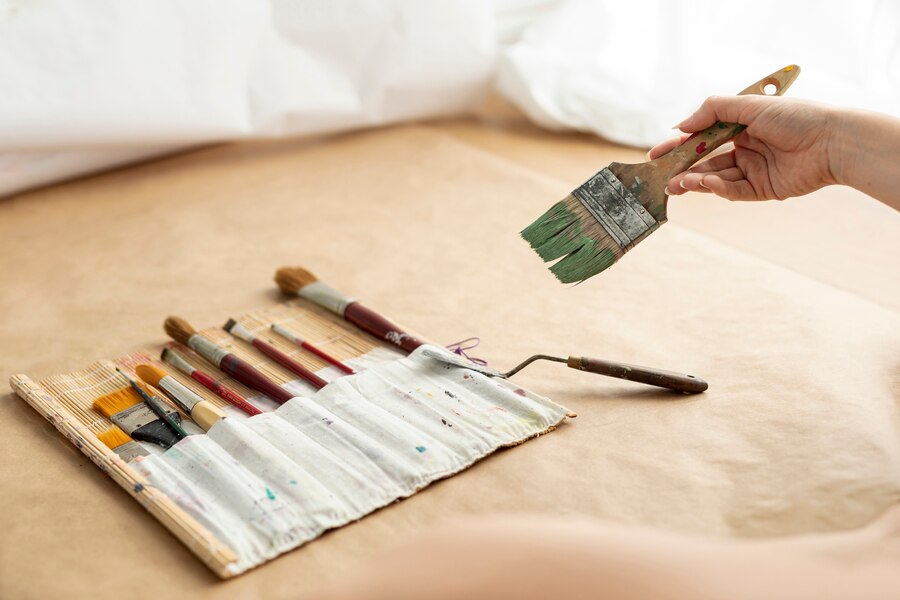
Cleaning and maintaining your paintbrushes is an essential skill for any artist, DIY enthusiast, or professional painter. Proper care not only extends the life of your brushes but also ensures that they perform optimally, giving you the best results every time you use them. Whether you’re working with acrylics, oils, watercolors, or any other medium, the way you clean and store your brushes can make a significant difference. In this article, we’ll delve into the best practices for cleaning and maintaining your paintbrushes, covering everything from immediate cleaning steps to long-term storage solutions. We’ll also provide outbound links to top resources and products that can help you keep your brushes in pristine condition.
Why Cleaning Your Paintbrushes is Crucial
Before diving into the how-to, it’s important to understand why cleaning your paintbrushes is so crucial. Paint residue can harden on the bristles, making them stiff and unusable. Over time, this can lead to permanent damage, forcing you to replace your brushes more frequently. Additionally, leftover paint can mix with new colors, leading to unintended results in your artwork. According to Bob Vila, neglecting to clean your brushes can also lead to bacterial growth, especially in water-based paints, which can be harmful if not properly managed. Therefore, regular and thorough cleaning is not just about maintaining the quality of your tools but also about ensuring your safety and the integrity of your work.
Immediate Cleaning Steps
The first step in maintaining your paintbrushes is to clean them immediately after use. The longer paint sits on the bristles, the harder it will be to remove. For water-based paints like acrylics and watercolors, start by rinsing the brush under warm running water. Use your fingers to gently work the paint out of the bristles. Avoid using hot water, as it can damage the bristles and loosen the glue that holds them together. For oil-based paints, you’ll need a solvent like mineral spirits or turpentine. Dip the brush into the solvent and swirl it around to loosen the paint. Then, wipe the brush on a paper towel or cloth to remove the excess. Repeat this process until the brush is clean. According to The Spruce, it’s essential to use the right solvent for the type of paint you’re working with to avoid damaging the bristles.
Deep Cleaning Techniques
While immediate cleaning is essential, sometimes your brushes will need a deeper clean, especially if they’ve been used extensively or have dried paint on them. For water-based paints, you can use a mild soap or brush cleaner. Wet the bristles and work the soap into a lather, then rinse thoroughly. For oil-based paints, you may need to use a more potent solvent like acetone or a specialized brush cleaner. Always follow the manufacturer’s instructions when using these products. According to Artists Network, it’s also a good idea to use a brush conditioner after deep cleaning to keep the bristles soft and pliable. This is particularly important for natural hair brushes, which can become brittle over time.
Drying Your Brushes Properly
Once your brushes are clean, proper drying is the next critical step. Never leave your brushes standing upright in a jar or container, as this can cause water or solvent to seep into the ferrule (the metal part that holds the bristles), loosening the glue and causing the bristles to fall out. Instead, lay your brushes flat on a clean towel or hang them upside down to dry. According to Winsor & Newton, using a brush holder or rack can help maintain the shape of the bristles and ensure even drying. If you’re in a hurry, you can gently squeeze out excess water with a paper towel, but avoid twisting or pulling the bristles, as this can cause damage.
Storing Your Brushes for Longevity
Proper storage is just as important as cleaning when it comes to maintaining your paintbrushes. Once your brushes are completely dry, store them in a way that protects the bristles from being bent or crushed. Many artists use brush holders or rolls made specifically for this purpose. These storage solutions keep the bristles straight and prevent them from coming into contact with other brushes, which can cause fraying. According to Jerry’s Artarama, it’s also a good idea to cover your brushes with a protective sleeve or wrap them in paper to keep dust and dirt away. If you’re storing brushes for an extended period, consider using a brush preserver, which coats the bristles in a protective layer to prevent them from drying out.
Special Care for Different Types of Brushes
Different types of brushes require different care techniques. For example, natural hair brushes, such as those made from sable or hog bristle, need more gentle cleaning and conditioning compared to synthetic brushes. Natural hair brushes are more prone to damage from harsh chemicals and rough handling, so always use a mild soap and avoid soaking them for extended periods. Synthetic brushes, on the other hand, are more durable and can withstand stronger cleaning agents. According to Golden Artist Colors, it’s essential to match your cleaning and maintenance routine to the type of brush you’re using to ensure longevity and optimal performance.
Common Mistakes to Avoid
Even with the best intentions, it’s easy to make mistakes when cleaning and maintaining your paintbrushes. One common error is using the wrong solvent for the type of paint you’re working with. For example, using water to clean oil-based paints won’t be effective and can lead to hardened bristles. Another mistake is not cleaning your brushes thoroughly enough, leaving behind residue that can harden and damage the bristles over time. According to Creative Bloq, it’s also important to avoid using excessive force when cleaning, as this can cause the bristles to break or fall out. Finally, never store your brushes in an airtight container, as this can trap moisture and lead to mold growth.
Tools and Products for Brush Maintenance
There are several tools and products available that can make cleaning and maintaining your paintbrushes easier and more effective. Brush cleaners, conditioners, and preservers are specifically designed to keep your brushes in top condition. A brush comb or spinner can help remove stubborn paint and reshape the bristles. According to Dick Blick, investing in high-quality cleaning products can save you money in the long run by extending the life of your brushes. Additionally, using a palette knife to remove excess paint before cleaning can make the process quicker and more efficient.
Eco-Friendly Cleaning Solutions
If you’re concerned about the environmental impact of using harsh chemicals to clean your brushes, there are eco-friendly alternatives available. For water-based paints, you can use biodegradable soaps or even homemade solutions like vinegar and baking soda. For oil-based paints, consider using citrus-based solvents, which are less toxic and more environmentally friendly. According to Eco Art Works, these alternatives are not only better for the planet but also safer for you to use, especially if you’re working in a poorly ventilated area.
Regular Maintenance Routine
Establishing a regular maintenance routine is key to keeping your paintbrushes in excellent condition. Make it a habit to clean your brushes immediately after each use, and set aside time for a deep clean every few weeks. Regularly inspect your brushes for signs of wear and tear, such as frayed bristles or loose ferrules, and address any issues promptly. According to Artist’s Loft, a consistent maintenance routine can significantly extend the life of your brushes and ensure they perform at their best.
Conclusion
Properly cleaning and maintaining your paintbrushes is an essential practice for anyone who uses them, whether you’re a professional artist or a weekend DIYer. By following the steps outlined in this article, you can extend the life of your brushes, ensure they perform optimally, and avoid common pitfalls that can lead to damage. Remember to clean your brushes immediately after use, use the right cleaning agents for the type of paint you’re working with, and store them properly to protect the bristles. With regular care and attention, your paintbrushes can remain in excellent condition for years to come, allowing you to focus on creating your best work. For more tips and resources on brush care, check out the links provided throughout this article, and don’t hesitate to invest in high-quality cleaning products and tools to make the process easier and more effective.
